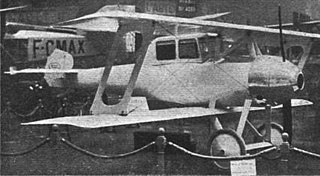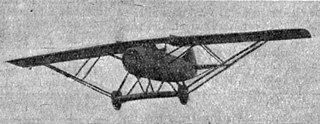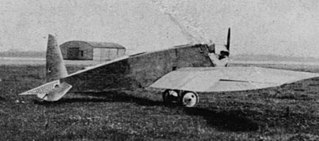
The Aero A.23 was a Czechoslovakian airliner of the 1920s. Aero Vodochody had produced the first Czech airliner, the A.10, four of which had served with ČSA, the national airline. The A.23, another biplane, was bigger, more powerful and could carry more passengers.

The Potez 40 was a French three-engine, braced high-wing monoplane designed and built in response to a French government programme for colonial transport and policing aircraft duties.
The Potez 27 was a French reconnaissance biplane first flown in 1924. 175 were operated by the Polish Air Force, most built in Poland by PWS under licence. Others went to Romania, where they were also used as light bombers.

The Feiro Dongó was a Hungarian side-by-side trainer biplane. It was notable for its high aspect ratio wings, aerodynamic clearness and high lift/drag ratio.

The de Marçay Limousine was a two-seat French touring biplane introduced at the 1919 Paris Aero Salon. A smaller but otherwise very similar single-seater was also there.

The Les Mureaux 3 C.2 and Les Mureaux 4 C.2 were French two seat, parasol winged fighters, flown in 1927-8, which differed only in their engines. They were developed into near identical army co-operation types, the ANF Les Mureaux 130 A.2 and ANF Les Mureaux 131 A.2, in 1929-31.

The Buscaylet-de Monge 7-5 was a twin engine, twin-boom aircraft without a fuselage but with pilot, passenger and fuel accommodated in a thickened wing centre-section. It was designed by Belgian pioneer Louis de Monge and built in France in the mid-1920s.

The Lachassagne AL 5 was a French low power, single seat sports aircraft with novel, in-flight variable camber wings and tailplane. It first flew in 1930; at least two were built.

The Salmson-Béchereau SB-5 was a two-seat fighter aircraft built for a French government programme in 1925. Despite a powerful engine it did not perform well and only one was built.
The Peitz 101, aka Peitz Avionette, was a French, amateur-built, all-metal light aircraft, first flown during the winter of 1931–32.
The Peyret Avionette was a low power, single seat French monoplane which won several first-place prizes at the Congrès Experimental contest of 1923.

The SABCA Demonty-Poncelet monoplane, Demonty-Poncelet limousine or SABCA-DP was a Belgian light aircraft first flown in 1924. It had two comfortable side-by side seats in a glazed cabin. Though it had competition successes in 1924 and 1925, it did not go into production.
The Caproni Ca.66 was an Italian night bomber designed to reequip the post-World War I Italian Air Force. Only two examples of the four-engined biplane were built.

The Dewoitine 14 was a mid-1920s French civil transport, capable of carrying mixture of passengers and freight. The sole example was used in commercial trials.

The Caspar C 17 was a mid-1920s German, low power, two seat ultralight aircraft with a cantilever wing of unusually high aspect ratio, flexibly attached to the fuselage to moderate gust effects.

The Magni PM.2 Vittoria was an Italian experimental, single seat, parasol wing aircraft built in the mid-1920s. It had a large area aerofoil on each of its single wing bracing struts which could be rotated together or independently to give lift or drag.
The CPA 1 was a French twin-engined, parasol-winged bomber designed and built in the mid-1920s.

The Hanriot H.25 was a French, single-engined, six passenger airliner built in 1926. Only one was flown.

The Skraba S.T.3 was a two-seat Polish biplane built in 1928. It was the first all-metal aircraft designed in Poland; only one was completed.

The Peyret-Nessler Libellule (Dragonfly) was a French two-seat, low-powered parasol wing light aircraft built in 1927 to provide practical but economical flying. It was one of the first of these French avionettes.















